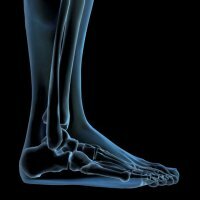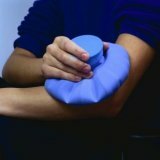Aseptic necrosis of calcaneus

Our feet throughout life are under a lot of stress when walking, running, inconvenience when wearing shoes, etc. It is not surprising that the leg bones begin to ache. Today we will talk about necrosis calcaneus.
Characteristics of the disease
Necrosis of the calcaneus is called another Haglund-Schintz disease, or the osteochondropathy of the apophysis of the heel bone. The disease was described for the first time in 1907 by orthopedic surgeon Haglund, and also in 1922 by Schintz and they gave it the name of aseptic necrosis of the apophyses of the calcaneus.
Active children aged 14-16 are most often affected, as well as athletes who have the main burden on their legs and joints.
Unfortunately, the exact cause of the disease is still not indicated, but it is conditionally believed that the cause is a violation of blood circulation, as well as traumas in the calcaneous part of the foot. In addition, there are vascular disorders, various endocrine disruptions, neuro-trophic disorders, various microtrauma, fatigue of the Achilles tendon, as well as excessive loads on the gastrocnemius muscle and the muscle of the sole of the foot.
Symptoms of the disease
Doctors identify the following symptoms that will help determine the presence of aseptic necrosis. Suspicion of necrosis may occur if the patient has pain while walking or flexing and flexing the foot. The disease occurs with swelling, pain, fever in the area of the calcaneal tendon and heel, as well as hyperemia in the same areas. To confirm the presence of such a diagnosis ultrasound, as well as X-ray examination of the patient, and only then, after thoroughly studying the pictures, the correct treatment is selected. When examining X-ray images, you can see how the salt begins to be deposited around the bone, and the distance between the apophysis and the calcaneus gradually increases due to the growth of the cartilage.
Treatment of
Treatment of the calcaneal bone entirely depends on how much the disease has developed. To begin with, it is necessary to observe peace and immobility of the foot in order to prevent possible exacerbations of necrosis. To do this, a langet is attached to the heel area of the feet, which ensures immobility. Then carry out physioprocedures, which will restore the blood supply in the necrotic calcaneus. To reduce pain in aseptic necrosis, you can use a special shoe in which there is a supinator, and the back is made larger, which allows you to reduce pressure on the heel area of the leg.
In the case of severe aseptic necrosis, surgical intervention is used in which removal of cartilage and bone growth occurs.
Aseptic necrosis of the heel is a rather unpleasant disease, but it's not worth worrying about, because the disease quickly recedes and the patient recovers.


